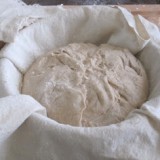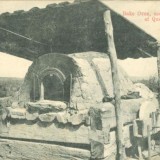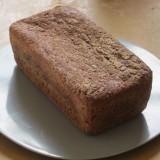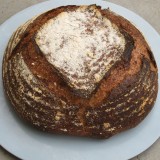Via Community Grains a mini-class by whole wheat baker Craig Ponsford. In this video you’ll see him make a whole wheat ciabatta. Some tips to point out:
- Ponsford doesn’t knead. Even though you’ll see him use a spiral mixer in this video, he’s incorporating the ingredients with water not kneading them. Developing the flour takes place not through kneading, but instead due to a long fermentation, a wet dough and the folding you’ll see him demonstrate. And you don’t need a spiral mixer. You can incorporate ingredients by hand or with a stand mixer. Just don’t knead!
- Baking requires a scale. Ponsford is very insistent about this and with good reason. As he puts it, when he hears about someone’s bread disaster, 99% of the time it’s because they did not use a scale.
- Rather than dust flour on work surfaces in order to handle dough you’ll see Ponsford use water instead. He also wets containers that he puts dough into. It’s a lot neater and less flour gets incorporated in the dough. Whole wheat doughs need to be wet. When he does use flour, as in the end of the video he’s using it strategically–in order to keep the loaf from getting to dark in the oven.
Baking bread is actually fairly simple as long as you realize that the devil is in the details. Use a scale and study how Ponsford handles the dough and you’ll get good results. And please marvel at the open crumb structure that Ponsford achieves with 100% whole wheat.
The recipe for this dough can be found here – a whole wheat pizza dough recipe is here.




Okay. So that totally blew my mind. That crumb is absolutely gorgeous. I didn’t think it was possible in whole wheat.
Now, the main reason I have been making sourdough is due to Andrew Whitely’s assertion it makes more easily digestible breads, due to the very long fermentation, whereas this bread only had a few hours.
So I was disappointed to see this bread uses instant yeast. Can this be made with sourdough? Can a poolish be made with sourdough?
This is beyond stretching my bread-making knowledge.
And as a side note…have you seen Tartine’s new whole wheat book yet?
Hey Ruben, I’m a fan of sourdough too. And, yes, this bread could be made with a starter. Ponford tends to use commercial yeast because he finds it more reliable and says that the long fermentation time he uses is a similar process. When he was asked about this in class he noted that there is no research as of yet to support the sourdough digestibility question. I’m not sure that I agree with Ponsford on this one but it’s hard to argue with someone with his level of experience. I’d like to hear a debate about this issue.
Digestibility doesn’t rely on research. My wife feels bloated after bread, or she doesn’t. It doesn’t matter what the research says, it doesn’t even matter if sourdough is a placebo and it is all in her mind. If she feels good after eating it, she will eat bread. If it makes her feel sick, she won’t eat it.
All that being said, I could try making bread with yeast, and see if the overnight poolish and the three hour ferment is enough for her digestion.
But, still I like sourdough. Call me romantic.
Have you made a sourdough poolish? I thought poolish were liquid, but his preferment was very dense. Do you have any suggestions?
The recipe has about a third of the ingredients in the poolish. So, should I:
1) feed my sourdough and let it rise (8 hours)
2) make a preferment (8 hours)
3) make a dough with preferment, flour and more sourdough (8 hours)
That sounds about right. It will be interesting to see if you get the same open crumb structure with a starter as Ponsford does with commercial yeast. Let me know if it works. And, I forgot to say, that I’m interested in seeing the new Tartine whole wheat book, though I’ve heard the recipes are a mixture of white/whole wheat.
Really? Dang. The original Tartine book has a “whole-wheat” recipe with white flour. I was hoping this one would be 100% WW focussed.
Don’t quote me on that–haven’t seen the book just yet.
And I will keep you posted as I experiment. But this weekend we are pressing apple cider, so it will be a while.
Mmmmm, cider . . .
Mr. Homegrown, don’t know if you have had a chance to look at Tartine 3 yet, but I saw it in a bookstore today, and it is indeed a mix of WW and white.
He plays a shifty little game by talking about WW, then “High extraction whole grain flour” by which he means flour that has lost 15-25% due to sifting, then bread flour, which I think is absolved because he is already sifting.
So, no true whole wheat bread from Tartine.
Yep. Spot on. I’m disappointed by it too. The only thing that can be said for it is that the instructions are better than the first Tartine bread book.
Ruben, I am interested in trying a sourdough version of this as well, but have trouble getting as much of an open crumb as pictured. Please do post if you come up with a successful recipe. Also, in looking at the Community Grains site, their is a lot made of the secret grinding process. I grind my own flour and often wonder if it would be better ground coarsely first and then more finely, although I have been too lazy to try it yet. Currently I have a lot of trouble with the bran slicing up the gluten strands. Any advice would be appreciated.
The course vs. fine issue is a complicated one that I don’t fully understand. If my memory serves me, the flour we used in class had a somewhat course texture. Another thing is that Ponford uses a lot of water in his doughs. Some are up to 110% hydration.
Michael Pollan’s new book Cooked mentions Community Grains. It seems the secret process is putting the wheat through a stone mill, hammer mill and roller mill.
http://books.google.ca/books?id=KHxP6J0PcxUC&pg=PT167&lpg=PT167&dq=david+miller+whole+wheat+bakery&source=bl&ots=YUf8SkYN1N&sig=jI6my7fI4tiS9yzos_n5YzI9Gk4&hl=en&sa=X&ei=MxiqUtDIM5LxoATHoIGwDg&ved=0CHUQ6AEwCA#v=onepage&q=vanderliet&f=false
Hi Pamina,
I am still working on it, but so far my best has been basically a no-knead bread that I developed by working it in a tub and then just poured into a hot dutch oven.
The hydration was very high, I think 110%.
The loaf is not crazy holey, but is the hole-iest I have made. Our nine year old ate her crusts.
So sorry to not have seen this thread earlier to be able to respond. We use a process called “whole milling.” This means we keep the whole grain intact throughout the entire milling process. The “secret” that results in 100% of the whole grain wheat being able to maintain shelf stability, full flavor and nutritional integrity is how it is cracked during the milling process. We mill extra fine to provide flour with great performance, texture and flavor. You can check out our Whole Grain Standard on our new website to learn a bit more. We are just about finished with a page that we will publish on our website that goes in to more detail about whole milling. Thanks so much for all your enthusiasm! http://www.communitygrains.com/our-whole-grain-standard/
Right now I do a single fine grind, which leaves everything fine except the bran. Maybe I’ll try a slightly coarser grind. I have started adding more water as well, which has really helped. Right now I am at 95% hydration, but perhaps I should continue upping that a little more! Thanks.
Oh man. They have a secret grinding process?
Pingback: Midweek reading, with bread | Wild Economies
What was the big solid lump that he added after the water and flour/yeast/salt/oil?
That’s the “biga.” Here’s the Wikipedia entry: http://en.wikipedia.org/wiki/Biga_(bread_baking).
Pingback: Wednesday Link Waterfall
I tried to get the link to the recipe, but it did not work.
I noticed Craig added 4 dry ingredients, not 3. Besides flour, salt and yeast what is the 4th dry ingredient? Could it be gluten?
I really want to try Craig’s recipe, but cannot find it anywhere.
Thanks,
Sam
Hey Sam–try again–links are working for me. Fourth ingredient is the “biga” or “poolish” a pre-ferment that you’ll see in the recipe. Let me know if you’re still unable to access it.
Thanks for the quick response.
I tried another browser and it worked.
By the way, the 4th dry ingredient is Pumpernickel flour.
Sam
OK, cool. At the Dave Miller workshop I just took this weekend the topic of “pumpernickel flour” came up. Miller says that pumpernickel is a kind of bread not a flour (confusing!). When people say pumpernickel they really mean dark rye flour, i.e. whole grain rye flour.
>Baking requires a scale. Ponsford is very insistent about this and with good reason. As he puts it, when he hears about someone’s bread disaster, 99% of the time it’s because they did not use a scale.
Hello. Could you explain please what this means?
Vlad–Cooks Illustrated did a test–measuring flour and water with cups vs. measuring with a scale. Once a month I repeat this test as a demo in bread classes that I teach. What the test shows is that people are routinely 20 to 30% off. That’s enough to turn a bread dough into either pancake batter on the wet side or a brick on the dry side. The other part of baking is more intuitive–knowing when the dough has risen enough to either shape or go in the oven. But I agree with Ponsford that you’ve got to get the ratios right at the beginning.
“Phytic acid (an organic acid in which phosphorus is bound) is present in all grains in the outer layer or bran. Untreated phytic acid can combine with calcium, magnesium, copper, iron and especially zinc in the intestinal tract and block their absorption. Soaking or fermenting or sprouting grains allows enzymes, lactobacilli and other helpful organisms to break down and neutralize phytic acid. A diet high in unfermented whole grains, particularly high-gluten grains like wheat, puts an enormous strain on the whole digestive system.
Soaking, fermenting or sprouting grains also neutralizes enzyme inhibitors, present in all seeds, and encourages the production of numerous beneficial enzymes. The action of these enzymes also increases the amounts of many vitamins, especially B vitamins. Enzyme inhibitors are part of the seed machinery and serve a purpose. But these inhibitors are out of place in our bodies. They could stop our own enzymes from working. Roasting seeds also neutralizes enzyme inhibitors, but does not provide the enhanced benefits of soaking, fermenting or sprouting.”
http://berkshiremountainbakery.com/the-bakery/
I agree with you Vlad. When I make bread I use a sourdough starter and long fermentation times. Ponsford uses commercial yeast in most of his breads and pastries. While I have great respect for him, I disagree with him on this.